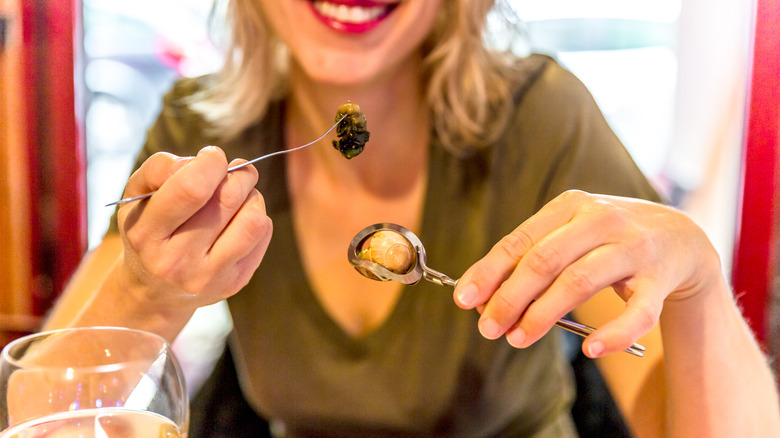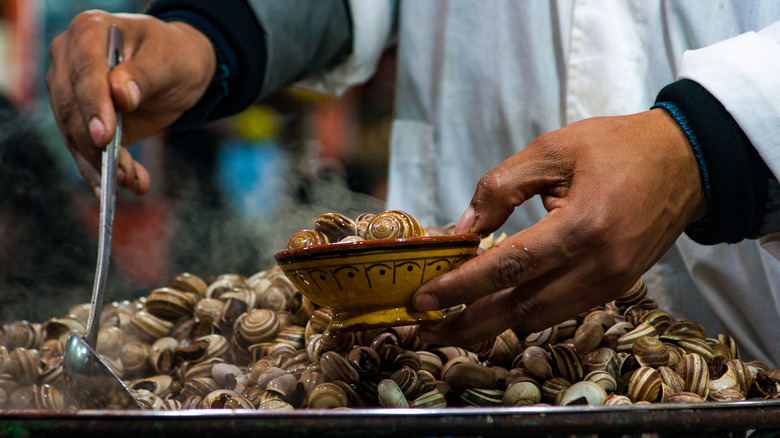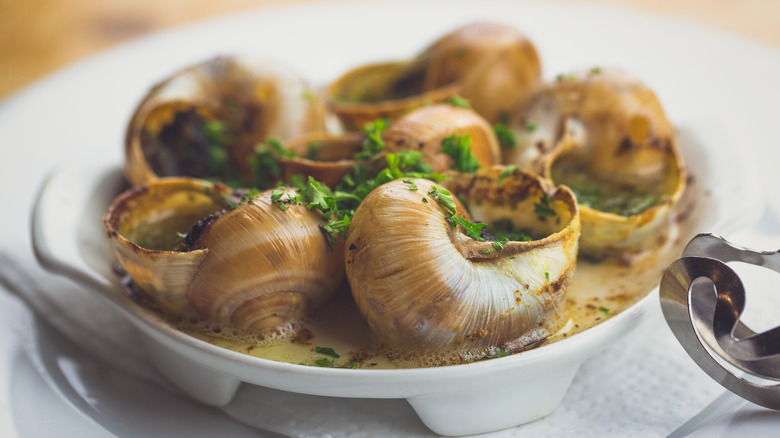How To Eat Escargot Like A True Parisian
When we think of French food and drink, what comes to mind is likely haute cuisine, or "high cooking." Small portions of expertly crafted and artfully plated dishes are served to us in fancy restaurants by serious servers in crisp white shirts. With this as our mental image, it may come as a shock that among these high-brow dishes are things often associated with the barnyard or forest floor: pig feet, frog legs, and yes, snails.
While some turn their noses up at them, snails are an esteemed delicacy we can trace back to the Romans and Gauls and have been eaten by the upper echelon ever since. France's King Louis XVIII is said to have served escargot to Emperor Alexander I of Russia following his defeat of Napoleon in 1814. Once you come around to the idea of eating this polarizing dish, how do you confidently take it on like a dignified Parisian? It may seem intimidating at first — and it's probably not a food you want to order on a first date if you've never had it before — but it's not hard to master. Just grab a shell with tongs, pull the flesh out with a specialized snail fork, and bon appétit!
Escargot preparation and handling
While there are many different ways to enjoy escargot around the world — Italy and Greece use escargot in pasta dishes while Spain prepares them as a tapa cooked in a flavorful tomato sauce — King Louis' preparation, using herbed garlic butter served in the shell, is still the tradition in France. Snails are typically boiled to kill any bacteria that may be present, removed from the shell, and cooked in whichever sauce, spices, and herbs are chosen. They're then placed back in the shell for serving.
Because escargot is usually removed from the shell during preparation, they're not too difficult to get out. There are special pieces of equipment necessary to properly enjoy this dish, however. Escargot in the shell arrives at your table in a snail dish, which is a metal serving dish with holes that prevent snail shells from rolling around on the plate. When you're ready to eat, carefully select one from the dish using the provided snail tongs, then remove the contents of the shell with a two-pronged escargot fork. If you feel so inclined, you're also welcome to sip the remaining juice out of the shell — just avoid grabbing shells with your fingers.
Think of escargot as land clams
It's okay to be apprehensive about trying an unfamiliar food for the first time, especially if your only association with this dish is the snails you've seen sliding around in your garden. But try not to put down your preconceptions about this dish before diving in. Not only is the slimy texture of snails lost in the cooking process, but the snails themselves also have a mild earthy flavor, and most of what you taste will be the ingredients used to cook them: wine, butter, garlic, and parsley.
In terms of texture, once cooked, escargot is tender and slightly chewy, with a mouthfeel that's often compared to a sauteed mushroom or the mollusks most of us are used to eating, like muscles and clams. Since these creatures belong to the same phylum as snails, their textural similarities should come as no surprise. So step slightly outside of your comfort zone and give escargot a shot — if you enjoy the aforementioned textures, you're already well on your way to becoming an escargot superfan.



